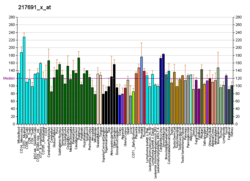Monocarboxylate transporter 4
Monocarboxylate transporter 4 (MCT4) also known as solute carrier family 16 member 3 is a protein that in humans is encoded by the SLC16A3 gene.[5][6]
Northern and western blotting and EST database analyses showed MCT4 to be widely expressed and especially so in glycolytic tissues such as white skeletal muscle fibers, astrocytes, white blood cells, chondrocytes, and some mammalian cell lines. Because of this, it has been proposed that the properties of MCT4 might be especially appropriate for export of lactate derived from glycolysis. MCT4 exhibits a lower affinity for most substrates and inhibitors than MCT1, with Km and Ki values some 5–10-fold higher. The high Km for pyruvate may be especially significant as this avoids loss of pyruvate from the cell which, were it to occur, would prevent removal of the reduced form of nicotinamide adenine dinucleotide (NADH) produced in glycolysis by reduction of pyruvate to lactate.
See also
References
- 1 2 3 GRCh38: Ensembl release 89: ENSG00000141526 - Ensembl, May 2017
- 1 2 3 GRCm38: Ensembl release 89: ENSMUSG00000025161 - Ensembl, May 2017
- ↑ "Human PubMed Reference:".
- ↑ "Mouse PubMed Reference:".
- ↑ Price NT, Jackson VN, Halestrap AP (Jan 1998). "Cloning and sequencing of four new mammalian monocarboxylate transporter (MCT) homologues confirms the existence of a transporter family with an ancient past". The Biochemical Journal. 329 ( Pt 2) (2): 321–8. PMC 1219047. PMID 9425115.
- ↑ "Entrez Gene: SLC16A3 solute carrier family 16, member 3 (monocarboxylic acid transporter 4)".
Further reading
- Halestrap AP, Price NT (Oct 1999). "The proton-linked monocarboxylate transporter (MCT) family: structure, function and regulation". The Biochemical Journal. 343 Pt 2 (2): 281–99. doi:10.1042/0264-6021:3430281. PMC 1220552. PMID 10510291.
- Halestrap AP, Meredith D (Feb 2004). "The SLC16 gene family-from monocarboxylate transporters (MCTs) to aromatic amino acid transporters and beyond". Pflügers Archiv : European Journal of Physiology. 447 (5): 619–28. doi:10.1007/s00424-003-1067-2. PMID 12739169.
- Maruyama K, Sugano S (Jan 1994). "Oligo-capping: a simple method to replace the cap structure of eukaryotic mRNAs with oligoribonucleotides". Gene. 138 (1–2): 171–4. doi:10.1016/0378-1119(94)90802-8. PMID 8125298.
- Suzuki Y, Yoshitomo-Nakagawa K, Maruyama K, Suyama A, Sugano S (Oct 1997). "Construction and characterization of a full length-enriched and a 5'-end-enriched cDNA library". Gene. 200 (1–2): 149–56. doi:10.1016/S0378-1119(97)00411-3. PMID 9373149.
- Kirk P, Wilson MC, Heddle C, Brown MH, Barclay AN, Halestrap AP (Aug 2000). "CD147 is tightly associated with lactate transporters MCT1 and MCT4 and facilitates their cell surface expression". The EMBO Journal. 19 (15): 3896–904. doi:10.1093/emboj/19.15.3896. PMC 306613. PMID 10921872.
- Philp NJ, Wang D, Yoon H, Hjelmeland LM (Apr 2003). "Polarized expression of monocarboxylate transporters in human retinal pigment epithelium and ARPE-19 cells". Investigative Ophthalmology & Visual Science. 44 (4): 1716–21. doi:10.1167/iovs.02-0287. PMID 12657613.
- Olsen JV, Blagoev B, Gnad F, Macek B, Kumar C, Mortensen P, Mann M (Nov 2006). "Global, in vivo, and site-specific phosphorylation dynamics in signaling networks". Cell. 127 (3): 635–48. doi:10.1016/j.cell.2006.09.026. PMID 17081983.
- Wang Q, Morris ME (Aug 2007). "The role of monocarboxylate transporter 2 and 4 in the transport of gamma-Hydroxybutyric acid in mammalian cells". Drug Metabolism and Disposition. 35 (8): 1393–9. doi:10.1124/dmd.107.014852. PMID 17502341.






